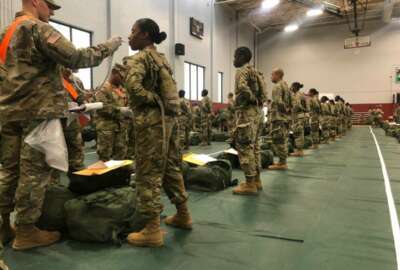The Army hit its endstrength recruiting goal of 485,000 – 485,383 more precisely – for fiscal 2020. Leaders said the COVID-19 pandemic has emphasized the importance of factors such as job flexibility and meeting young people where they are – even if that’s online.
That included 336,131 troops for the Army National Guard and 188,703 troops for the Army Reserve, according to Deputy Chief of Staff for Personnel Lt. Gen. Gary M. Brito. He said he expects the end-strength to grow by about 1,500 additional soldiers by the end of FY 2021.
A major reason for hitting 2020 goals, however, was less attrition and more personnel staying with the service.
“The Army did make a few changes to the enlisted promotion and retention policies to take care of those soldiers that decided to serve, take care of our people and most importantly ensure our readiness stayed at the highest level it could to keep our Army ready at all times,” said Brito during a conference call with reporters Friday.
Examples of this included short-term re-enlistment opportunities, and moving from what Brito called “an industrial age to a 21st-Century talent management process.” Army G-1 Sgt. Maj. Mark Clark said 1,664 soldiers took the short-term re-enlistment option to extend by three to 11 months, and 139 of them ended up re-enlisting, while 1,002 of them chose to extend all the way into FY 2021.
To help understand what soldiers desired most, the Army conducted job satisfaction surveys.
“We also developed a few programs and policies to align soldiers with the jobs that they were best fit for, based off their talents, skills they possessed, and their preferences. And we offered this for all ranks. Although it started off focused on the officer corps, we’ve offered this for the senior enlisted and enlisted as well, and so far the feedback’s been very positive,” he said.
But COVID-19 definitely brought challenges, and that’s where Maj. Gen. Kevin Vereen, commanding general of U.S. Army Recruiting Command, said recruiting innovations made all the difference.
“Innovation in this business is essential. Between our recruiters’ ingenuity, with virtual recruiting, our eSports, our fitness and musical outreach teams, our efforts online and our nationwide call to action with the Army National hiring days – we found ways to connect with America, even when we couldn’t see them face to face,” Vereen said.
Maj. Gen. John Evans Jr., commanding general of U.S. Army Cadet Command, said he looks at officer commissions as a three-to-five-year cycle because recruits are typically coming from high school or an ROTC program. Yet for FY 2020 they slightly surpassed their 6,000-goal, with 6,090 lieutenants commissioned – the first time since 2014 that the mission was achieved in all three components: Active force, Army Reserve and the Army National Guard.
The successes taught leaders that despite face-to-face interactions being the most effective recruiting method, going virtual was still worthwhile when the target demographic – teens and young adults – are not in school or able to be found at normal commercial or social gathering spots, but are instead at home.
“We’re still trying to stay ahead of the ballgame when it comes to what districts are closed, what districts are online, what districts are doing hybrid [learning] because we don’t want to lose that face-to-face contact,” Vereen said. “But it has really streamlined our processing … about 90% of our ability, we can do it online now.”
Brito added that COVID also meant training intake procedures for recruits changed, from pick-ups at the airport to moving through mess halls and barracks. Soldiers underwent temperature checks and were screened for the virus to mitigate infection spread.
Vereen also said having female recruiters on the ground who can answer questions and share their stories makes a difference for improving diversity of new troops. He said that 18.1% of regular Army recruits were women in FY 2020 – a number which has not much changed – while 47% were from minority populations.
“I tell … my male recruiting noncommissioned officers that you can’t walk in a female’s shoes and explain the experiences of what will occur as a female in our Army. I mean, they want to talk to a female,” he said.
Among the 6,000 or so officers commissioned, Evans said the Army is still assessing the numbers but he expected to improve from last year’s stats of 12% African American, 11% Hispanic, 8% Asian American and Pacific Islander, and 2% unspecified or other racial backgrounds. Evans said he and Brito are working on encouraging more diversity particularly in the traditional combat arms branches from where, 25 or 30 years down the line, many senior general officers are likely to emerge.
Editor’s note: The original version of this story incorrectly identified officials’ commands.
Copyright
© 2024 Federal News Network. All rights reserved. This website is not intended for users located within the European Economic Area.
